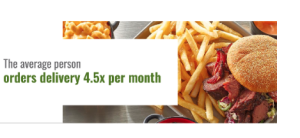Recent data released on how and where Americans eat reflects a shifting landscape that leans towards casual convenience. Since the onset of the pandemic, consumers are sticking to their takeout and delivery trends, according to a survey by U.S. Foods.
The study asked 1,000 consumers about their dining preferences, ordering habits, favorite restaurant types and more. Those surveyed report dining out three times per month and ordering delivery more than four times per month—with 57 percent saying they prefer takeout or delivery, while 43 percent prefer eating at a restaurant.
The great debate: order in or dine out?
What motivates people to order in rather than eat out? Seventy-six percent report it’s enjoyable to eat at home, 75 percent say it’s the convenience factor, 50 percent like to watch TV, 49 percent prefer not having to cook and 32 percent choose takeout or delivery so that they can wear comfortable clothes and avoid getting ready.

A survey by U.S. Foods reports the average person dines out 3x per month and orders delivery 4.5x per month.
When it comes to delivered food, it’s a given that it can sometimes arrive not in the same quality and temperature as it would at a restaurant and is more likely to take longer to receive. But the majority surveyed pushed those factors aside, with 54 percent saying they are willing to wait over 30 minutes for off-premises orders.
The survey found that wait times and food quality (temperature, presentation) are among main indicators for choosing to dine out. The top reason, however, is atmosphere and socialization—with 63 percent reporting experience as the main driver for heading to the restaurant.
Casual dining experiences are listed as the most popular model, followed by fast food, fast casual, contemporary casual and bars and grills.
For optimizing the experience, those surveyed want their paper menus back with more than two in four Americans stating they prefer physical menus to a QR code menu format. However, 31 percent of Gen Z respondents prefer QR codes to physical menus.
Universally, the cost of meals is a major contributing factor to how often and where Americans go out to eat.
Depending on where consumers dine, eating at restaurants, especially fast-casual versus fine dining, can often end up cheaper than delivery due to fees. The average person reports spending at least $20 per person when eating out whereas delivered meals can often cost higher due to fees.
Again, this reaffirms that convenience remains a top priority among consumers as many are willing to pay more or sacrifice quality to enjoy food in the comfort of their own home.


